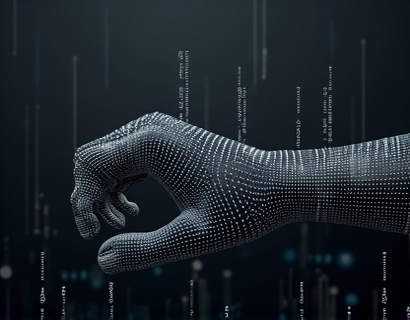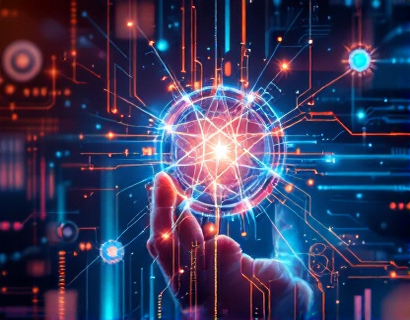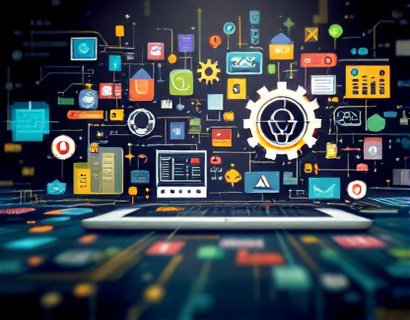Crypto AI Synergy: Revolutionizing Digital Transformation for Early Adopters and Tech Innovators
The intersection of cryptocurrency and artificial intelligence (AI) is giving rise to a new era of digital transformation. This synergy is not just a technological curiosity but a powerful force that is redefining how we interact with digital systems and platforms. For early adopters and tech innovators, the fusion of these advanced technologies offers unprecedented opportunities to elevate their digital presence and create seamless, innovative applications that enhance user experiences.
The integration of AI and cryptocurrency is creating a robust ecosystem where data is securely and efficiently processed, transactions are transparent and tamper-proof, and applications are smarter and more responsive. This article delves into the transformative power of this combination, exploring how it can drive digital transformation and empower tech-savvy individuals and organizations.
Understanding the Basics: AI and Cryptocurrency
To fully appreciate the synergy between AI and cryptocurrency, it's essential to understand the fundamentals of each technology.
Artificial Intelligence refers to the simulation of human intelligence processes by machines, particularly computer systems. These processes include learning (the acquisition of information and rules for using it), reasoning (using rules to reach approximate or definite conclusions), and self-correction. AI technologies such as machine learning, natural language processing, and computer vision are rapidly advancing, enabling machines to perform tasks that traditionally required human intervention.
Cryptocurrency, on the other hand, is a digital or virtual currency that uses cryptography for security. It operates on a decentralized network, typically a blockchain, which ensures transparency and immutability. Bitcoin, the first and most well-known cryptocurrency, paved the way for thousands of alternative coins (altcoins) and decentralized applications (dApps). Cryptocurrencies facilitate peer-to-peer transactions without the need for intermediaries, reducing costs and increasing efficiency.
The combination of AI and cryptocurrency leverages the strengths of both technologies. AI can enhance the functionality and security of blockchain networks, while blockchain can provide a secure and transparent environment for AI models to operate and share data.
Enhancing Security and Transparency
One of the most significant benefits of integrating AI with cryptocurrency is the enhancement of security and transparency. Blockchain's inherent properties make it an ideal platform for secure data storage and transaction processing. AI can further bolster these properties by detecting and preventing fraudulent activities in real-time.
For instance, machine learning algorithms can analyze transaction patterns to identify anomalies that may indicate fraud. These algorithms can be trained on historical data to recognize normal behavior and flag deviations, ensuring that the network remains secure. Smart contracts, self-executing contracts with the terms directly written into code, can also benefit from AI. AI can automate the verification and execution of smart contracts, reducing the risk of human error and increasing efficiency.
Transparency is another area where AI and cryptocurrency synergize. Blockchain's decentralized ledger provides a transparent record of all transactions, which can be audited by anyone. AI can enhance this transparency by providing real-time analytics and insights into the data stored on the blockchain. This can help stakeholders make informed decisions and build trust in the system.
Optimizing Performance and Efficiency
The integration of AI with cryptocurrency also leads to optimized performance and efficiency. Blockchain networks, while secure, can be slow and resource-intensive, especially when processing complex transactions. AI can help streamline these processes by optimizing the way data is handled and transactions are executed.
For example, AI can be used to optimize consensus mechanisms in blockchain networks. Traditional consensus mechanisms like Proof of Work (PoW) are energy-intensive and slow. AI can assist in developing more efficient consensus algorithms, such as Proof of Stake (PoS) or Delegated Proof of Stake (DPoS), by analyzing network conditions and adjusting parameters in real-time. This can lead to faster transaction times and lower energy consumption.
Additionally, AI can improve the scalability of blockchain networks. By predicting network traffic and optimizing resource allocation, AI can help manage the load and prevent bottlenecks. This ensures that the network remains responsive and efficient, even as the number of users and transactions grows.
Empowering Smart Applications
The combination of AI and cryptocurrency is giving birth to a new generation of smart applications that are more intelligent, responsive, and user-friendly. These applications leverage the power of AI to provide personalized experiences and the security and transparency of blockchain to ensure trust and reliability.
Decentralized finance (DeFi) platforms are a prime example of this synergy. DeFi applications offer a range of financial services, from lending and borrowing to trading and yield farming, all built on blockchain networks. AI can enhance these platforms by providing predictive analytics, risk assessment, and automated trading strategies. This not only improves the user experience but also opens up new opportunities for investors and users.
Another area where AI and cryptocurrency are making waves is in the Internet of Things (IoT). IoT devices generate vast amounts of data that can be processed and analyzed using AI. By integrating blockchain, this data can be securely and transparently shared among devices and platforms. AI can optimize the data flow, ensuring that only relevant and useful information is processed, thereby enhancing the efficiency of IoT systems.
Personalized User Experiences
One of the most exciting aspects of AI and cryptocurrency synergy is the ability to create highly personalized user experiences. AI algorithms can analyze user behavior, preferences, and interactions to deliver tailored content and services. When combined with the secure and transparent nature of blockchain, these experiences become even more robust.
For instance, in the realm of digital content, AI can curate personalized news feeds, recommendations, and entertainment based on user preferences. Blockchain can ensure that content creators are fairly compensated for their work, with transparent and traceable transactions. This not only enhances the user experience but also supports a more equitable and sustainable content ecosystem.
In the world of e-commerce, AI-driven chatbots and virtual assistants can provide personalized shopping experiences, recommending products and offering real-time support. Cryptocurrency can facilitate seamless and secure transactions, eliminating the need for intermediaries and reducing fees. This combination can revolutionize the way we shop online, making it more efficient and user-friendly.
Building Decentralized Communities
The synergy between AI and cryptocurrency is also transforming how communities are built and managed. Decentralized autonomous organizations (DAOs) are a prime example of this transformation. DAOs are community-driven organizations that operate on blockchain networks, governed by smart contracts and AI-driven decision-making processes.
AI can enhance DAOs by providing data-driven insights and predictive analytics, helping members make informed decisions. For example, AI can analyze market trends, community sentiment, and other relevant data to suggest strategic actions. This can lead to more effective governance and a stronger sense of community.
Moreover, AI can facilitate better communication and collaboration within DAOs. Natural language processing (NLP) can be used to analyze and summarize discussions, ensuring that all members are on the same page. AI-driven tools can also automate routine tasks, freeing up time for members to focus on more strategic and creative endeavors.
Challenges and Considerations
While the potential of AI and cryptocurrency synergy is vast, there are several challenges and considerations that must be addressed. One of the primary concerns is regulatory compliance. The decentralized and often anonymous nature of cryptocurrency transactions can pose challenges for regulators. However, AI can help navigate these challenges by providing tools for compliance monitoring and reporting.
Another challenge is the technical complexity involved in integrating AI with blockchain. Developing robust and secure systems requires expertise in both domains. Collaboration between AI researchers, blockchain developers, and industry experts is crucial to overcome these technical hurdles.
Privacy is also a significant concern. While blockchain offers transparency, it can also expose sensitive information. AI can help address this by implementing advanced encryption techniques and privacy-preserving algorithms. Differential privacy, for example, allows for data analysis without revealing individual data points, ensuring that user privacy is maintained.
Future Prospects
The future of AI and cryptocurrency synergy is bright, with numerous potential applications and innovations on the horizon. As technology continues to evolve, we can expect to see more sophisticated and integrated solutions that further enhance digital transformation.
One area of interest is the development of AI-powered decentralized identity solutions. These solutions can give users control over their digital identities, allowing them to securely and privately manage their online presence. AI can help verify identities and prevent fraud, while blockchain ensures that identity data is tamper-proof and user-controlled.
Another promising direction is the integration of AI with non-fungible tokens (NFTs). NFTs have gained popularity in the art and collectibles space, but their potential extends to various industries, including gaming, real estate, and supply chain management. AI can enhance NFTs by providing dynamic and interactive experiences, personalized content, and smart contract-based governance.
Furthermore, the convergence of AI, cryptocurrency, and 5G technology is set to revolutionize the way we connect and interact in the physical and digital worlds. With faster and more reliable connectivity, AI-driven applications can process and analyze data in real-time, creating seamless and immersive experiences.
Conclusion
The synergy between AI and cryptocurrency is a powerful force that is reshaping the digital landscape. For early adopters and tech innovators, this combination offers a wealth of opportunities to create innovative solutions that enhance online experiences and drive digital transformation. By leveraging the strengths of both technologies, we can build more secure, efficient, and personalized systems that empower users and foster a more inclusive and sustainable digital ecosystem.
As we continue to explore and harness the potential of AI and cryptocurrency, the possibilities are endless. The future is not just promising; it is transformative, and those who embrace this synergy will be at the forefront of the next digital revolution.











































